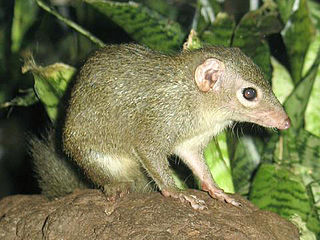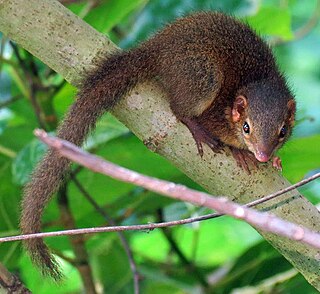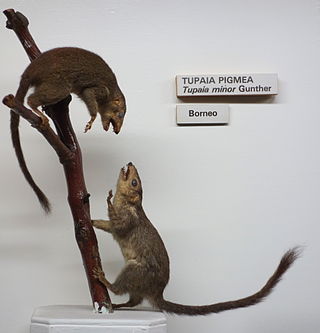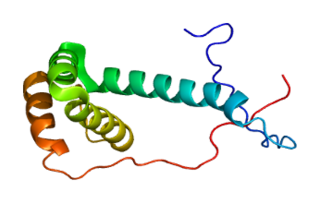
The treeshrews are small mammals native to the tropical forests of South and Southeast Asia. They make up the entire order Scandentia, which split into two families: the Tupaiidae, and the Ptilocercidae.

Brain–body mass ratio, also known as the brain–body weight ratio, is the ratio of brain mass to body mass, which is hypothesized to be a rough estimate of the intelligence of an animal, although fairly inaccurate in many cases. A more complex measurement, encephalization quotient, takes into account allometric effects of widely divergent body sizes across several taxa. The raw brain-to-body mass ratio is however simpler to come by, and is still a useful tool for comparing encephalization within species or between fairly closely related species.

The Madras treeshrew, also known as the Indian treeshrew, is a species of treeshrew in the monotypic genus Anathana found in the hill forests of central and southern India. The genus name is derived from the Tamil name of moongil anathaan and the species name is after Sir Walter Elliot of the Indian Civil Services in Madras.

The common treeshrew is a small mammal in the treeshrew family Tupaiidae, and is native to Thailand, Malaysia, and Indonesia. It has been listed as Least Concern by IUCN as it remains common and displays some adaptability to ongoing habitat loss.

The liver receptor homolog-1 (LRH-1) also known as totipotency pioneer factor NR5A2 is a protein that in humans is encoded by the NR5A2 gene. LRH-1 is a member of the nuclear receptor family of intracellular transcription factors.

Horsfield's treeshrew, also called Javan treeshrew, is a treeshrew species within the Tupaiidae. It is endemic to the Indonesian islands of Sumatra, Bali, Java and Nias where it inhabits foremost primary forest.

The pygmy treeshrew is a treeshrew species within the family Tupaiidae. It is native to Thailand, Malaysia and Indonesia. The generic name is derived from the Malay word tupai meaning squirrel or small animals that resemble squirrels.

The mountain treeshrew is a treeshrew species within the Tupaiidae. It is endemic to Borneo and inhabits montane forests in Sarawak and Sabah, Malaysia, and Kalimantan, Indonesia.

The large treeshrew is a treeshrew species within the Tupaiidae. It is native to Sumatra and adjacent small islands, as well as in the lowlands and hills of Borneo.

Programmed cell death protein 5 is a protein, originally identified as an apoptosis-accelerating protein, that in humans is encoded by the PDCD5 gene.

Cell death-inducing DFFA-like effector b, also known as CIDEB, is a human gene.

The Mindanao treeshrew, also called the Philippine tree shrew, is a species of treeshrew endemic to the Mindanao region in the Philippines. It was formerly considered the only member of the genus Urogale, but that genus was merged into Tupaia when the species was found to nest within the latter genus in a molecular phylogeny. The scientific name commemorates British colonial administrator and zoological collector Alfred Hart Everett.

Tupaia is a treeshrew genus in the family Tupaiidae that was first described by Thomas Stamford Raffles in 1821. The name of this genus derives from the Malay word tupai meaning squirrel or small animal resembling a squirrel.

Tupaiidae is one of two families of treeshrews, the other family being Ptilocercidae. The family contains three living genera and 19 living species. The family name derives from tupai, the Malay word for treeshrew and also for squirrel which tupaiids superficially resemble. The former genus Urogale was disbanded in 2011 when the Mindanao treeshrew was moved to Tupaia based on a molecular phylogeny.
The transmission of hepadnaviruses between their natural hosts, humans, non-human primates, and birds, including intra-species host transmission and cross-species transmission, is a topic of study in virology.
Kang Zhang is a Chinese-American ophthalmologist specializing in ophthalmic genetics and aging processes in the eye. He is currently a Professor of the Faculty of Medicine at Macau University of Science and Technology. He was previously a Professor of Ophthalmology and the Founding Director of the Institute for Genomic Medicine at the University of California, San Diego. Zhang is particularly known for his work on lanosterol, stem cell research, gene editing, and artificial intelligence.

















